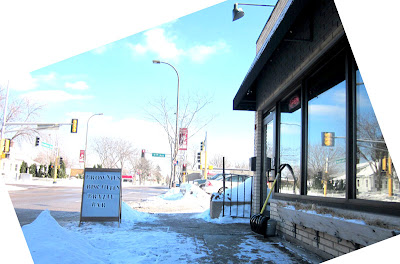 [Basically the problem is that the best source of Saint Paul streets & sidewalks news is the Highland Villager, a very fine and historical newspaper. This wouldn't be a problem, except that its not available online. You basically have to live in or frequent Saint Paul to read it. That's why I'm reading the Highland Villager so that you don't have to. Until this newspaper goes online, sidewalk information must be set free.]
[Basically the problem is that the best source of Saint Paul streets & sidewalks news is the Highland Villager, a very fine and historical newspaper. This wouldn't be a problem, except that its not available online. You basically have to live in or frequent Saint Paul to read it. That's why I'm reading the Highland Villager so that you don't have to. Until this newspaper goes online, sidewalk information must be set free.]Total # of articles about sidewalks: 9
Total # of articles about sidewalks written by Jane McClure: 9
Headline: St. Paul readies for next round of ash removal; Highland to lose 201 more trees, public encouraged to help treat healthy ones
Reporter: Jane McClure
Short short version: The emerald ash borer is still boring into ash trees, and 201 more will meet the axe. [Interesting question: will the city of Saint Paul cut more budgets or more trees this year?]
Headline: Getting out while they still can; Some University Ave. shops are relocating, closing in anticipation of light-rail project
Reporter: Jane McClure
Short short version: Vaguely alarmist bit about shops that are closing down rather than attempt to survive the decreased revenues that will accompany the construction period (and loss of street parking) that comes with the Central Corridor LRT project. Complete list of closed or closing businesses: Martha's Garden floral design, Chocolat Celeste chocolates (last fall), Swank Retro, Cafe Bonxai. Article also includes detail that the University Avenue Business Association (UABA) has now changed its name to the University Avenue Betterment Association (UABA).
Headline: University braces for nine months of light-rail construction
Reporter: Jane McClure
Short short version: Article about the construction work on University, which is set to begin "as early as March 1" [tomorrow!] near Hamline Avenue. Article includes construction schedule, discussion about sidewalk width during construction, concerns over State Fair access, glimpses at logistical complexity.
Headline: West 7th Federation supports new Schmidt Brewing Historic District
Reporter: Jane McClure
Short short version: The West 7th neighborhood group voted to support an attempt to have the area around the brewery declared an historic district. The St. Paul Heritage Preservation and Planning Commissions still have to vote on it. Article includes description of potential development in the brewery, discussion of mixed-use dreams, quotes from developers, some history of brewery's roots back in 1850s. [I wonder if Jane McClure is ever tempted to just cut and paste previous articles while she's writing? -Ed.]
Headline: Bye-bye, love; Milton Mall remodeling bumps out Amoré Coffee
Reporter: Jane McClure
Short short version: Sad story about loss of Amoré coffee and its replacement by a Anthropologie store. [They made a good ristretto and had a nice sidewalk table with a lovely view of the SuperAmerica gas pump. -Ed.]
Headline: HDC committee opposes permit for Max It Pawn shop on West 7th
Reporter: Jane McClure
Short short version: The Highland District Council does not want a conditional use permit to be given to a pawn shop business that wants to move into the vacated Nedved's Flower shop on western West 7th Street.
Headline: BZA wants rental signs removed
Reporter: Jane McClure
Short short version: An apartment building in Highland Park has too many "for rent" signs in its yard, and the Board of Zoning Appeals is pissed. Current regulations only allow for "no more than six square feet," but the apartment owner has "six vinyl signs" on the apartment's fence for a grand total of 352 square feet. Apparently the building owner argued (unsuccessfuly) that this was discrimination by using the example of Wing Yung Huie's giant photos on the side of the Rondo Library (but which were art, and not advertisements for rental apartments).
Headline: Group brainstorm on ways to make Snelling Ave. a more complete street; Improved safety, accessibility sought as part of summer's resurfacing, bridge projects
Reporter: Jane McClure
Short short version: Report on the recent (jam packed) community meeting about doing a complete streets treatment along Snelling. Article has quotes from many of the different non-profits involved, including Sierra Club, Transit for Liveable Communities, and the St Paul Bicycle Coalition [any of whom you can contact if you'd like to know more -Ed.]. Ideas include, bike lanes, lower speed limits, bump-outs, crosswalks, pedestrian-activated crossing signals, and narrower lanes. Medians were not included in this list.
Headline: City adopts interim zoning on West End
Reporter: Jane McClure
Short short version: The city has passed in interim zoning code in the West End that restricts conversions of single-family homes into multi-family homes.




 In a lot of ways, the Twin Cities' working class roots are invisible today. Gone from sight are the mills and factories belching smoke. Gone are the masses of men shuffling back and forth to work. Gone are the worker's houses. They're all expensive now, bought by people with nice gardens who appreciate a brick.
In a lot of ways, the Twin Cities' working class roots are invisible today. Gone from sight are the mills and factories belching smoke. Gone are the masses of men shuffling back and forth to work. Gone are the worker's houses. They're all expensive now, bought by people with nice gardens who appreciate a brick.

































